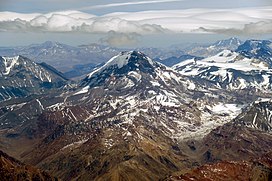| Tupungato | |
|---|---|
 Aerial view of Tupungato volcano from Argentina. | |
| Highest point | |
| Elevation | 6,570 m (21,560 ft)[A] |
| Prominence | 2,765 m (9,072 ft)[1] |
| Listing | Ultra |
| Coordinates | 33°21′30″S 69°46′12″W / 33.35833°S 69.77000°W[1] |
| Geography | |
| Location | Mendoza Province, Argentina – Metropolitan Region, Chile |
| Parent range | Principal Cordillera, Andes |
| Geology | |
| Rock age | Pleistocene[2] |
| Mountain type | Lava dome[2] |
| Volcanic arc/belt | South Volcanic Zone |
| Last eruption | 0.8 million years ago.[3] |
| Climbing | |
| First ascent | 1897 by Matthias Zurbriggen and Stuart Vines |
Tupungato, one of the highest mountains in the Americas, is a massive Andean lava dome dating to Pleistocene times.[2] It lies on the Argentina–Chile border, between the Chilean Metropolitan Region (near a major international highway about 80 km (50 mi) east of Santiago) and the Argentine province of Mendoza, about 100 km (62 mi) south of Aconcagua, the highest peak of both the Southern and Western hemispheres. Immediately to its southwest is the active Tupungatito volcano (literally, little Tupungato), which last erupted in 1987.
Tupungato Department, an important Argentine wine-producing region in Mendoza province, is named for the volcano. Recent Chilean mapping indicates it has a height of 6635m.[4]
Cite error: There are <ref group=upper-alpha> tags or {{efn-ua}} templates on this page, but the references will not show without a {{reflist|group=upper-alpha}} template or {{notelist-ua}} template (see the help page).
- ^ a b "Argentina and Chile, Central Ultra Prominences". Peaklist.
- ^ a b c González Díaz, Emilio F. (1961). "Contribución al Conocimiento de la Petrografía del Cerro Tupungato (Provincia de Mendoza) y de otras Rocas Efusivas de la Región". Dirección Nacional de Geología y Minería (in Spanish). Retrieved 2 August 2022.
- ^ "Tupungato". Global Volcanism Program. Smithsonian Institution.
- ^ Biggar, John (2020). The Andes – A Guide for Climbers and Skiers (5th ed.). Andes. p. 265. ISBN 978-0-9536087-6-8.
